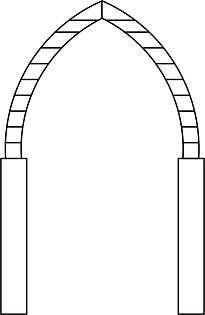


The Point of Pointed Arches


During the Gothic era, builders discovered that pointed arches would give structures amazing strength and stability. They experimented with varying steepness, and "experience had shown them that pointed arches thrust out less than circular arches," says famed architect and engineer Mario Salvadori. "The main difference between Romanesque and Gothic arches lies in the pointed shape of the latter, which, besides introducing a new aesthetic dimension, has the important consequence of reducing the arch thrusts by as much as fifty percent."
In Gothic buildings, the weight of the roof was supported by the arches rather than the walls. This meant that walls could be thinner.
A pendentive is a constructive device permitting the placing of a circular dome over a square room or an elliptical dome over a rectangular room.[1] The pendentives, which are triangular segments of a sphere, taper to points at the bottom and spread at the top to establish the continuous circular or elliptical base needed for the dome.[2] In masonry the pendentives thus receive the weight of the dome, concentrating it at the four corners where it can be received by the piers beneath.

Autocad


